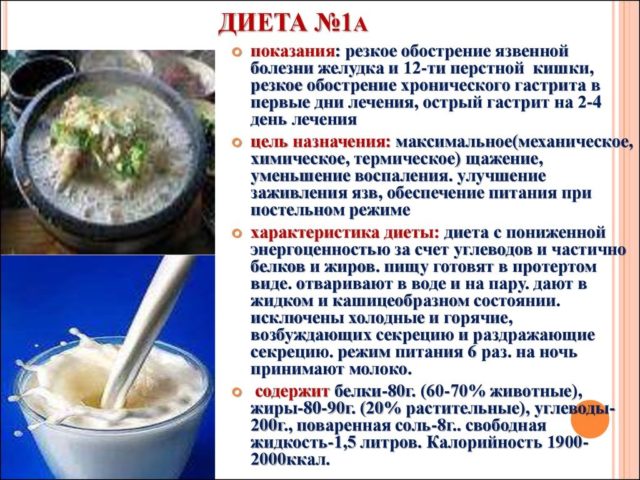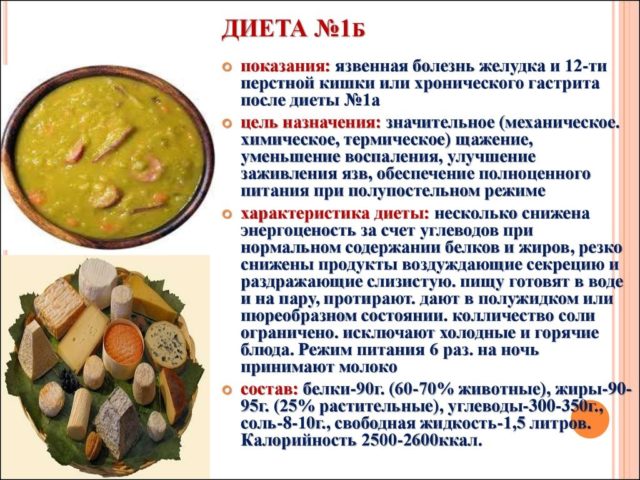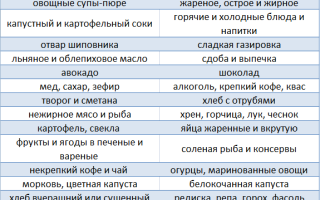Content
Under gastroduodenitis, it is customary to understand an inflammatory disease that affects the mucous membrane of the stomach and duodenum. Most often, the cause of the pathological process is infection with the bacterium Helicobacter Pylori. The disease is considered one of the varieties of chronic gastritis. Treatment involves not only the use of medications, but also the elimination of harmful products from the diet. During this period, a suitable diet and nutrition for erosive gastroduodenitis is very important for the patient.
Nutritional features for erosive gastroduodenitis
Erosive gastroduodenitis can occur in two forms - acute and chronic. Often, people are diagnosed with the second type of disease, which passes with alternating periods of remission and exacerbation.
Diet for such a pathology is an important part of therapeutic therapy. The composition of the diet depends on the form and course of the pathology, as well as on the data of the pH-metry of the stomach.
But the principles of nutrition for any of these pathologies are the same - it is necessary to take care of the state of the mucous membrane. All foods that can lead to even the slightest damage to the tissues of the stomach and small intestine are removed from the diet.
Dishes are exclusively served puree. Before use, they are thoroughly boiled and ground. If food comes across with pieces, then they need to be chewed well.
It is forbidden to eat food cold or hot. The list also includes those products that cause chemical irritation. Limit salt intake.
Diet menu for erosive gastroduodenitis
With an exacerbation of erosive gastroduodenitis, the patient is prescribed diet No. 1. On the first day, the doctor recommends completely refusing food. It is allowed to consume a small amount of boiled water and tea without added sugar.
The next day, the patient is prescribed diet No. 1A. The reduction in calories occurs due to the consumption of carbohydrates and a small amount of proteins and fats.
It is forbidden to eat foods that lead to the excitation of secretion and irritation of the gastric walls. Food is steamed or boiled. After that, grind. The amount of salt per day is reduced to 6 g.
Along with proper nutrition, bed rest must be observed. Food is divided into several approaches. A patient with erosive gastroduodenitis should consume up to 1.5 liters of fluid.

After 6-8 days the patient is transferred to diet No. 1B. It aims to stimulate the regeneration of the gastric mucosa and pancreas. This type of diet involves limiting carbohydrates, but with a normal protein and fat content. The main dish is slimy broth soup. Completely exclude solid foods, cold and hot foods.

As soon as the patient's condition returns to normal, he is prescribed diet number 1. You don't have to grind food anymore. But the diet includes dishes that are boiled, stewed and baked. The amount of salt per day should not exceed 8-10 g.
It is allowed to eat salads from boiled vegetables, mild cheeses, doctor's sausage. The bread should be white, but yesterday's. Olive and linseed oils are used as fats.Meals include eating protein foods such as rabbit, chicken and turkey.
Allowed Products
The period of exacerbation of the disease is accompanied by severe pain. Therefore, the diet for erosive gastroduodenitis in the first weeks includes:
- yesterday's white bread;
- crackers;
- milk-based soups with cereals and pasta;
- milk containing drinks;
- steamed omelet;
- vegetable soups;
- steamed cutlets and meatballs;
- meat in the form of beef, veal, chicken, turkey and rabbit, boiled or steamed;
- low-fat varieties of fish.
You can drink jelly, tea with a small amount of sugar, compotes.
Prohibited foods
Diet and nutrition for erosive gastroduodenitis is aimed at preserving the mucous membrane and preventing irritation.
Therefore, the patient is prohibited from eating:
- rich pastries and fresh bread;
- concentrated meat broths;
- mushroom broth;
- fatty fish and meat;
- pickles, marinades;
- spice;
- fermented milk products with high fat content;
- spicy and fatty varieties of sauces (ketchup, mayonnaise);
- chocolate, cakes and pastries;
- black bread;
- sausages;
- semi-finished products;
- some types of vegetables (onions, garlic, radishes, cabbage);
- fruits with high acidity (pineapple, orange, tangerine, lemon);
- the grape juice.

Diet for erosive gastroduodenitis for a week
For a patient who was diagnosed with erosive gastroduodenitis, at first it is difficult to get used to a new diet. To make the task easier, doctors draw up a rough menu for a week.
On the first day:
- Breakfast - rice porridge in milk and water, baked apple and low-fat cottage cheese.
- For the second breakfast - semolina porridge.
- In the daytime - vegetable soup with cream, steamed fish, jelly.
- For an afternoon snack - grated apple, 2 crackers and fruit juice.
- In the evening - buckwheat porridge, tea with sugar.
- Before going to bed - a glass of fermented baked milk.
On the second day:
- For breakfast - boiled egg, 2 crackers, tea with milk.
- For the second breakfast - curd pudding, chamomile tea.
- In the daytime - soup with buckwheat, steamed omelet, apple compote.
- For an afternoon snack - fruit salad.
- In the evening - cheesecakes with sour cream, tea with sugar.
- Before going to bed - a glass of fat-free kefir.
On the third day:
- Breakfast - oatmeal with milk, coffee drink.
- For lunch - a banana.
- In the daytime - baked meat soufflé, jelly.
- For an afternoon snack - cottage cheese casserole.
- In the evening - steamed fish, mashed potatoes, carrot and apple salad, tea with milk.
- Before going to bed - a glass of vegetable juice.
On the fourth day:
- In the morning - buckwheat porridge with milk, 2 crackers, tea with sugar.
- For the second breakfast - a sandwich with butter, juice.
- In the daytime - noodle soup, boiled rice with liver, dried fruit compote.
- For an afternoon snack - low-fat cottage cheese and baked pear.
- In the evening - rice casserole, tea without sugar
- Before going to bed - natural yoghurt without additives.
On the fifth day:
- In the morning - oatmeal with diluted milk, chicory.
- For lunch - an apple.
- In the daytime - soup with chicken broth, breast with buckwheat. Compote.
- For an afternoon snack - a salad of carrots and raisins.
- In the evening - steamed cutlets, boiled rice, jelly.
- Before going to bed - a glass of fermented baked milk.
On the sixth day:
- In the morning - cottage cheese casserole, 2 biscuits, tea with sugar.
- For lunch - a baked apple.
- In the daytime - vegetable soup, salad of beets and raisins, jelly.
- For an afternoon snack - low-fat cottage cheese.
- In the evening - baked low-fat fish, stewed vegetables, compote.
- Before going to bed - chamomile tea.
On the seventh day:
- In the morning - steamed omelet, tea with sugar.
- For the second breakfast - apple-pear puree, 2 croutons.
- In the daytime - rice porridge, raisin compote.
- For an afternoon snack - a glass of natural yogurt without additives.
- In the evening - boiled beef, vegetable puree.
- Before going to bed - rosehip decoction.

Conclusion
Diet and nutrition with erosive gastroduodenitis is aimed at reducing the load on the affected areas of the stomach and duodenum, restoring the mucous membrane. The menu is made by the doctor based on the signs of the disease. Failure to follow the recommendations can lead to an exacerbation of pathology and the development of complications.

